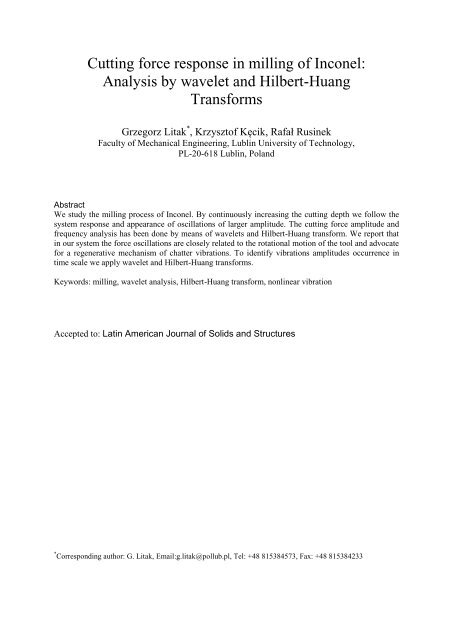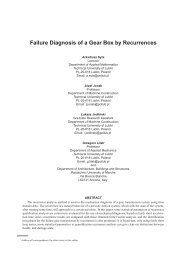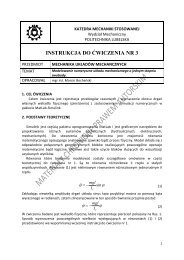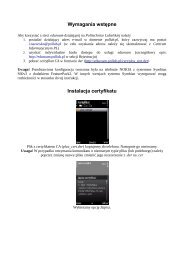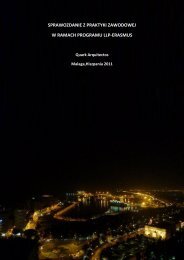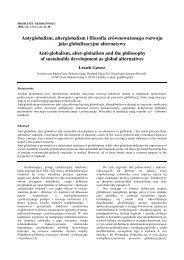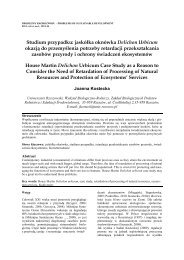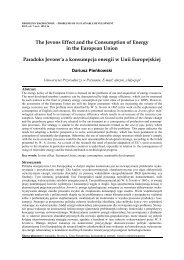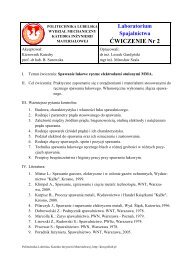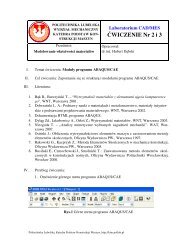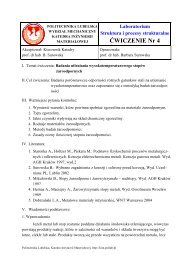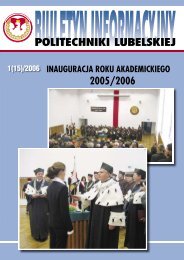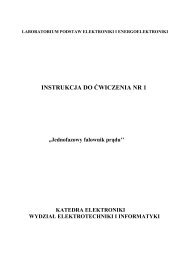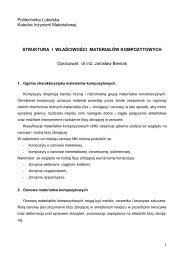Analysis by wavelet and Hilbert-Huang Transforms - Grzegorz Litak
Analysis by wavelet and Hilbert-Huang Transforms - Grzegorz Litak
Analysis by wavelet and Hilbert-Huang Transforms - Grzegorz Litak
- No tags were found...
You also want an ePaper? Increase the reach of your titles
YUMPU automatically turns print PDFs into web optimized ePapers that Google loves.
Cutting force response in milling of Inconel:<strong>Analysis</strong> <strong>by</strong> <strong>wavelet</strong> <strong>and</strong> <strong>Hilbert</strong>-<strong>Huang</strong><strong>Transforms</strong><strong>Grzegorz</strong> <strong>Litak</strong> * , Krzysztof Kęcik, Rafał RusinekFaculty of Mechanical Engineering, Lublin University of Technology,PL-20-618 Lublin, Pol<strong>and</strong>AbstractWe study the milling process of Inconel. By continuously increasing the cutting depth we follow thesystem response <strong>and</strong> appearance of oscillations of larger amplitude. The cutting force amplitude <strong>and</strong>frequency analysis has been done <strong>by</strong> means of <strong>wavelet</strong>s <strong>and</strong> <strong>Hilbert</strong>-<strong>Huang</strong> transform. We report thatin our system the force oscillations are closely related to the rotational motion of the tool <strong>and</strong> advocatefor a regenerative mechanism of chatter vibrations. To identify vibrations amplitudes occurrence intime scale we apply <strong>wavelet</strong> <strong>and</strong> <strong>Hilbert</strong>-<strong>Huang</strong> transforms.Keywords: milling, <strong>wavelet</strong> analysis, <strong>Hilbert</strong>-<strong>Huang</strong> transform, nonlinear vibrationAccepted to: Latin American Journal of Solids <strong>and</strong> Structures* Corresponding author: G. <strong>Litak</strong>, Email:g.litak@pollub.pl, Tel: +48 815384573, Fax: +48 815384233
1 IntroductionThe modern massive production cannot most often exist without the machiningtechnology. The problems of dynamical instabilities of cutting process <strong>and</strong> associated harmfulchatter vibrations were known for many years.The recent development of cutting <strong>and</strong> milling concepts <strong>and</strong> techniques gave way toimprove the process stability in fairly high speed cutting [1]. Consequently, identification ofthe chatter oscillations, <strong>and</strong> their elimination or even stabilization on some low level havebecome a high interest in science <strong>and</strong> technology [2-7]. Altintas [2] presented vibration <strong>and</strong>experimental modal analysis of the machine-tool system in a cutting process. A special focuswas placed on chatter vibration generation <strong>by</strong> the regenerative effect. Additionally, theselection of drive actuators, feedback sensors, the design of real time trajectory generation <strong>and</strong>interpolation algorithms were discussed. Warminski et al [3] considered a model of the metalcutting process in the context of an approximate analysis of the resulting non-lineardifferential equations of motion. The technological parameters for the avoidance of primarychatter were presented. Insperger <strong>and</strong> Mann [4] analyzed the stability conditions for up- <strong>and</strong>down-milling operations using the semi-discretization method. The authors restricted theirstudy to a single degree-of-freedom milling model with a linear cutting force <strong>and</strong> a singlecutting tooth. The method of temporal finite elements was applied in the paper [5]. Theperiodic chatter-free motion of the tool <strong>and</strong> the corresponding surface location error (SLE)were obtained <strong>by</strong> solving the differential equations. It was shown that the SLE was large atthe spindle speeds where the ratio of the dominant frequency of the tool <strong>and</strong> the tooth passingfrequency was an integer [6]. The stability lobe diagrams <strong>and</strong> the corresponding frequencydiagrams are compared for milling models with <strong>and</strong> without runout [7]. The plausibleadaptive control concept, based on relatively short time series, has been studied to gain deeperunderst<strong>and</strong>ing of cutting <strong>and</strong> milling processes [8, 9].Recently, new materials have been widely tested in various applications including aircraftparts due to their high specific strength <strong>and</strong> stiffness, low density <strong>and</strong> corrosion resistance.Inconel was one of the materials due to its high strength over a wide temperature range. It alsoforms a thick, stable, passivating oxide layer protecting from corrosion.The disadvantage of Inconel is the difficulty of using traditional machining techniques dueto rapid work hardening. After the first pass of the tool in cutting or milling, work hardeningcan plastic deform the workpiece on subsequent passes. Therefore Inconel is considered as amaterial of hard machinability [10, 11, 12], <strong>and</strong> consequently, minimizing the number of toolpasses is suggested.2 Experimental procedure <strong>and</strong> measurementsThe measurements were carried out on a vertical machining centre FV580A with the Fanuc0iMC control system (Fig. 1). Forces were measured using a Kistler 9257B dynamometer <strong>and</strong>a 5017B charge amplifier <strong>and</strong> the sample <strong>and</strong> hold component (SC2040) <strong>and</strong> the analogdigitalconverter NI6071E (National Instrument). The SC-2040 module is an eight-channelsimultaneously sampling differential amplifier produced <strong>by</strong> National Instrument Company.Microprocessor-controlled Multichannel Charge Amplifier type 5017B is especially used forcombined force <strong>and</strong> moment measurements together with piezoelectric multicomponentdynamometers.
The cutting forces generated on the workpiece during the machining are measured <strong>by</strong>dynamometer mounted on the milling machine. The corresponding force signals are transmitted to charge amplifier next to module sample & hold <strong>and</strong> finally to analog-digitalconverter, which is connected to a computer system. The sampling rate of data reorderedduring the test was fixed to 5kHz. The material used in the experiment is Inconel 718 (nickelsuperalloy). In the experiment, the solid carbide end mill no. F4BT1200AWX45R100(Kennametal) with a diameter of 12mm <strong>and</strong> 4 cutting blades is used during machining. Theradial depth of cut is two thirds of end milling diameter (8mm).3 Wavelet <strong>and</strong> <strong>Hilbert</strong>-<strong>Huang</strong> analysesWavelets have been used for time series analysis in a wide variety of applications. Waveletanalysis provides a spectral-temporal approach to identify the dominant modes of variabilityin a time series <strong>and</strong> to delineate how these modes vary over time [8, 9, 13] The continuous<strong>wavelet</strong> transform (CWT) of the time series F x (n) with respect to a mother <strong>wavelet</strong> ψ(t) isgiven <strong>by</strong> the convolution of the time series with a scaled <strong>and</strong> translated version of ψ(t). Theconvolution is expressed <strong>by</strong> [14]:F n Fxx *N t ( ') ( n' n)tW ( s, n) ,n ' 1s s (1) Fxwhere < F x >, σ Fx denote the mean value <strong>and</strong> st<strong>and</strong>ard deviation of the cutting forcecomponent F x , δt denotes the sampling interval, while an asterisk on ψ the complexconjugate. In Eq. (1) n <strong>and</strong> n′ ϵ [1,N] enumerate the sampled values of force F x . Furthermore,in W(s, n), the symbols s <strong>and</strong> n are scale <strong>and</strong> time indices, controlling the dilatation orcontraction <strong>and</strong> indicating the location of time instant in the examined time series. Morlet<strong>wavelet</strong> consists of a plane wave modulated <strong>by</strong> a Gaussian function <strong>and</strong> is described <strong>by</strong> [14] ( ) exp(i / 2),(2)1/4 20where the nondimensional frequency ω 0 = 2f 0 defines the order of the <strong>wavelet</strong>, with f 0 beingthe center frequency, i is an imaginary unit, <strong>and</strong> the argument η defines dimensionless time(as in Eq. (1)). The value of ω 0 controls the number of oscillations that is present in themother <strong>wavelet</strong> <strong>and</strong> thus influences the frequency <strong>and</strong> time resolutions of the corresponding<strong>wavelet</strong> transform. A larger value of ω 0 provides a higher frequency resolution whereas asmaller value improves the time resolution. In our computations, we have used a Morlet<strong>wavelet</strong> of order ω 0 = 6 as the mother <strong>wavelet</strong>. This choice provides a good balance betweentime <strong>and</strong> frequency localizations.The <strong>wavelet</strong> power spectrum (WPS)Pw2 W( s, n)(3)is a measure of the variance at different scales or frequencies. The WPS which depends onboth scales, frequency <strong>and</strong> time, can be applied to non-stationary time series (Fig. 2). Theresults of CWT are presented in Fig. 3. P w changes with changing time <strong>and</strong> period (inversefrequency f −1 ) is represented <strong>by</strong> a corresponding color (or shade of gray). It is worthmentioning, that P w reaches maximum values for spindle frequency of f=1/0.06 Hz=1000
more regular. This could be due to the specific plastic deformations which the surface isexposed on after each tool pass. Note that the larger cutting depth can minimize this effect[12].In contrast to previous experimental studies [4], where the stability of the milling processwhere investigated for a series of different depths h, we performed the inclined milling withcontinuously increasing cutting depth. Such a procedure enabled us to monitor the stability ofmilling in the real time <strong>and</strong> to find the critical cutting depth beyond which the milling processbecomes unstable. In our case it was about h≈0.3 mm which corresponds to t≈16 s (see modes5 <strong>and</strong> 6 in Fig. 4).On the other h<strong>and</strong>, we claim that the <strong>Huang</strong> decomposition can be also very useful methodto identify the chatter vibrations itself. It could be used to study the nonstationary signal likeour force response to the increasing cutting depth. This is observed in Fig. 4 where the modes5 <strong>and</strong> 6 are signaling the appearance of harmful chatter vibrations in the technological processof milling. This multiresolution analysis can be combined with other statistical <strong>and</strong>/orsymbolic methods to define the efficient indicators of chatter appearance. All calculations <strong>and</strong>graphs were made <strong>by</strong> using MATLAB.AcknowledgementsThis research has been partially supported <strong>by</strong> European Union within the frameworkIntegrated Regional Development Operational Programme as the project POIG.0101.02-00-015/08.References[1] G. Quintana, J. Ciurana, Chatter in Machining processes: A review, Int. J. Mach. ToolsManuf. 51, 363–376 (2011).[2] Y. Altintas, Manufacturing Automation: Metal Cutting Mechanics, Machine ToolVibrations, <strong>and</strong> CNC Design, Cambridge University Press, Cambridge 2000.[3] J. Warminski, G. <strong>Litak</strong>, M.P. Cartmell, R. Khanin, <strong>and</strong> M. Wiercigroch, Approximateanalytical solutions for primary chatter in the nonlinear metal cutting model,J. Sound Vibr.259, 917–933 (2003).[4] B.P. Mann, T. Insperger, P.V. Bayly, G. Stepan, Stability of up-milling <strong>and</strong> down-milling,part 2: experimental verification, Int. J. Mach. Tools Manuf. 43, 35–40 (2003).[5] B.P. Mann, P.V. Bayly, M.A. Davies, J.E. Halley, Limit cycles, bifurcations, <strong>and</strong> accuracyof the milling process, J. Sound Vibr. 277, 31–48 (2004).[6] T. Insperger, J. Gradisek, M. Kalveram, G. Stepan, K. Winert, <strong>and</strong> E. Govekar, Machinetool chatter <strong>and</strong> surface location error in milling processes, Journal of Manufacturing Science<strong>and</strong> Engineering 128, 913–920 (2006).[7] T. Insperger, B.P. Mann, T. Surmann, G. Stepan, On the chatter frequencies of millingprocesses with runout, Int. J. Mach. Tools Manuf. 48, 1081–1089 (2008).[8] A.K. Sen, G. <strong>Litak</strong>, A. Syta, Cutting process dynamics <strong>by</strong> nonlinear time series <strong>and</strong><strong>wavelet</strong> analysis, Chaos 17, 023133 (2007).[9] A.K. Sen, G. <strong>Litak</strong>, A. Syta, R. Rusinek, Complex dynamics in milling of fiber-reinforcedcomposites, Meccanica 2012, submitted.[10] H.Z. Li, H. Zeng, X.Q. Chen, An experimental study of tool wear <strong>and</strong> cutting forcevariation in the end milling of Inconel 718 with coated carbide inserts, Journal of MaterialsProcessing Technology 180, 296–304 (2006).[11] A. Devillez, F. Schneider, S. Dominiak, D. Dudzinski, D. Larrouquere, Cutting forces<strong>and</strong> wear in dry machining of Inconel 718 with coated carbide tools, Wear 262, 931–942(2007).
[12] K. Kecik, R. Rusinek, J. Warminski, Stability lobes analysis of nickel superalloysmilling, Int. J. Bif. Chaos 21, 1–12 (2011).[13] P. Kumar, E. Foufoula-Georgiou, Wavelet analysis for geophysical applications, Rev.Geophys. 35, 385–412 (1997).[14] C. Torrence, G.P. Compo, A practical guide to <strong>wavelet</strong> analysis, Bull. Amer. Meteorol.Soc. 79, 61–78 (1998)[15] N.E. <strong>Huang</strong>, Z. Shen, S.R. Long, M.L.C. Wu, H.H. Shih, Q.N. Zheng, N.C. Yen, C.C.Tung, H.H. Liu, The empirical mode decomposition <strong>and</strong> the <strong>Hilbert</strong> spectrum for nonlinear<strong>and</strong> non-stationary time series analysis, Proc. Roy. Soc. Lond. 454, 903–993 (1998).[16] D. <strong>Hilbert</strong>, Grundzuege einer allgemeinen Theorie der linearen Integralgleichungen,Chelsea Pub. Co., New York 1953 (282 pages).[17] M. Feldman, <strong>Hilbert</strong> transform in vibration analysis, Mech. Sys. Sig. Process. 25, 735-802 (2011).[18] P. Lajmert, An application of <strong>Hilbert</strong>-<strong>Huang</strong> transform <strong>and</strong> principal component analysisfor diagnostics of cylindrical plunge grinding process, Journal of Machine Engineering 10,39–49 (2010).[19] P. Lajmret, B. Kruszczynski, A diagnostic system for cylindrical plunge grinding processbased on <strong>Hilbert</strong>-<strong>Huang</strong> transform <strong>and</strong> principal component analysis. Adv. Manuf. Sci.Technol. 34, 19–31 (2010).
(a)(b)Figure 1: Photo of the experimental set-up (CNC machine) with a view of the tool (a).Examples of workpieces after milling (b). The machined workpiece was samped with theinclination angle 0.65 o to the horizontal line to satisfy inclined milling (milling withincreasing cutting depth). Nominal parameters of the milling process, cutting feed ratefr = 100mm/min, increasing cutting depth from 0 to 4mm, rotational speedn = 1000rpm, relative average cutting speed in x direction v x ≈37.7m/min.
Figure 2: Time history of the forces F x in the process of milling the wedge. The measurementprocess cutting tool is gradually recessed in the material. Founded sampling was 5kHz. Thedepth of cut is increasing h = 0.01878×t ( expressed [mm] units). Initial <strong>and</strong> final parts of plot(lasting 0.5s) have been used in the next more detailed analysis.
Figure 3: Wavelet power spectrum P w (Eq. 2) for the force F x in the process of milling.In the right panel a colour logarithmic scale of P w is shown.
Figure 4: First six <strong>Huang</strong> modes of decompositions. Note that, Mode No. 5 <strong>and</strong> 6increases considerably after reaching t = 16s.
(c)(d)
(e)(f)Figure 5: Instantaneous amplitude-frequency graphs for the initial (blue colour) <strong>and</strong> final(red colour) intervals (indicated in Fig. 2) for all six modes (a-f) presented in Fig 4.


